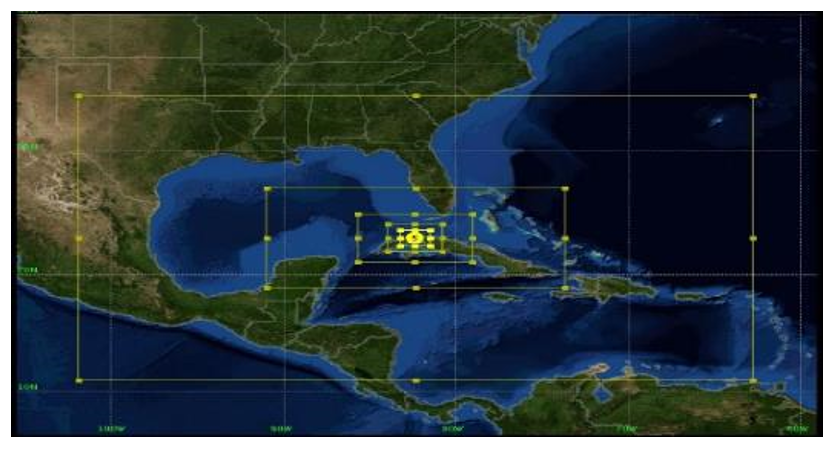Physical-numerical study of the prefrontal line that affected Havana on January 27, 2019
Main Article Content
Abstract
A numerical simulation was performed with the WRF model for January 27, 2019 with the objective of evaluating the physical-dynamic factors that caused the formation of vortices in the prefrontal line, as well as the causes of the strong gust reported at the Casablanca station at the passage of this system. It was found, from the simulation, that the horizontal shear instability was the trigger for the vortices ahead of the front, one of which was later developed by a convective updraft. The presence of a rear inflow current was found to cause the observed bow echo formation, vortex development and surface winds of category EF0 on the enhanced Fujita scale.
Downloads
Article Details

This work is licensed under a Creative Commons Attribution-NonCommercial 4.0 International License.
Those authors who have publications with this journal accept the following terms of the License Attribution-NonCommercial 4.0 International (CC BY-NC 4.0):
You are free to:
- Share — copy and redistribute the material in any medium or format
- Adapt — remix, transform, and build upon the material
The licensor cannot revoke these freedoms as long as you follow the license terms.
Under the following terms:
- Attribution — You must give appropriate credit, provide a link to the license, and indicate if changes were made. You may do so in any reasonable manner, but not in any way that suggests the licensor endorses you or your use.
- NonCommercial — You may not use the material for commercial purposes.
- No additional restrictions — You may not apply legal terms or technological measures that legally restrict others from doing anything the license permits.
The journal is not responsible for the opinions and concepts expressed in the works, they are the sole responsibility of the authors. The Editor, with the assistance of the Editorial Committee, reserves the right to suggest or request advisable or necessary modifications. They are accepted to publish original scientific papers, research results of interest that have not been published or sent to another journal for the same purpose.
The mention of trademarks of equipment, instruments or specific materials is for identification purposes, and there is no promotional commitment in relation to them, neither by the authors nor by the publisher.
References
Atkins, N. T., and M. St. Laurent, 2009: Bow Echo Mesovortices. Part II: Their Genesis. Mon. Wea. Rev., 137,1514–1532, https://doi.org/10.1175/2008MWR2650.1.
Carbone, R. E., 1982: A Severe Frontal Rainband. Part I. Stormwide Hydrodynamic Structure.J.Atmos.Sci.,39,258–279,https://doi.org/10.1175/1520-0469(1982)039<0258:ASFRPI>2.0.CO;2.
Clark MR, Parker DJ. Synoptic-scale and mesoscale controls for tornadogenesis on cold fronts: A generalised measure of tornado risk and identification of synoptic types. Q J R Meteorol Soc. 2020; 146: 4195–4225. https://doi.org/10.1002/qj.3898
Conrad, D. M., and K. R. Knupp, 2019: Doppler Radar Observations of Horizontal Shearing Instability in Quasi-Linear Convective Systems. Mon. Wea. Rev., 147, 1297–1318, https://doi.org/10.1175/MWR-D-18-0257.1.
Fjørtoft, R., 1950: Application of integral theorems in deriving criteria of stability for laminar flows and for the baroclinic circular vortex. Geofys. Publ., 17, 52.
Fujita, T. T., 1981: Tornadoes and downbursts in the context of gener-alized planetary scales. J. Atmos. Sci., 38, 1511–1534, doi:10.1175/1520-0469(1981)038 , 1511:TADITC . 2.0.CO;2.
Haurwitz, B., 1949: the Instability of Wind Discontinuities and Shear Zones in Planetary Atmospheres. J. Meteor., 6, 200–206, 10.1175/1520 0469(1949)006<0200:TIOWDA>2.0.CO;2
Helmus, J.J. & Collis, S.M., (2016). The Python ARM Radar Toolkit (Py-ART), a Library for Working with Weather Radar Data in the Python Programming Language. Journal of Open Research Software. 4(1), p.e25. DOI: http://doi.org/10.5334/jors.119
Investigating Vortexgenesis from Quasi-Linear Convective Systems in the United Kingdom Buckingham, T. (Author). 31 Dec 2022. Student thesis: Phd
Lee, B. D., and R. B. Wilhelmson, 1997: The Numerical Simulation of Nonsupercell Tornadogenesis. Part II: Evolution of a Family of Tornadoes along a Weak Outflow Boundary. J. Atmos. Sci., 54, 2387–2415, https://doi.org/10.1175/1520-0469(1997)054<2387:TNSONT>2.0.CO;2.
Okubo, A., 1970: Horizontal dispersion of fl oatable particles in the vicinity of velocity singularities such as convergences. Deep-Sea Res., 17, 445–454, https://doi.org10.1016/0011-7471(70)90059-8.
Orlanski, I. (1975). A rational subdivision of scales for atmospheric processes. Bull.Amer. Meteorol. Soc., 56 (5), 527–530 pp.
Rayleigh, L. (1879), On the Stability, or Instability, of certain Fluid Motions. Proceedings of the London Mathematical Society, s1-11: 57-72. https://doi.org/10.1112/plms/s1-11.1.57
Skamarock, W. C., Klemp, J. B., Dudhia, J., Gill, D. O., Barker, D., Duda, M. G., … Powers, J. G. (2008). A Description of the Advanced Research WRF Version 3 (No. NCAR/TN-475+STR). University Corporation for Atmospheric Research. http://dx.doi.org/10.5065/D68S4MVH
Smull, B. F., and R. A. Houze, 1987: Rear Inflow in Squall Lines with Trailing Stratiform Precipitation. Mon. Wea. Rev., 115, 2869–2889, https://doi.org/10.1175/1520-0493(1987)115<2869:RIISLW>2.0.CO;2.
Trapp, R. J., and M. L. Weisman, 2003: Low-Level Mesovortices within Squall Lines and Bow Echoes. Part II: Their Genesis and Implications. Mon. Wea. Rev., 131, 2804–2823, https://doi.org/10.1175/1520-0493(2003)131<2804:LMWSLA>2.0.CO;2.
Weiss, J., 1991: The dynamics of enstrophy transfer in two-dimensional hydrodynamics. Physica D, 48, 273–294, https://doi.org/10.1016/0167-2789(91)90088-Q.

